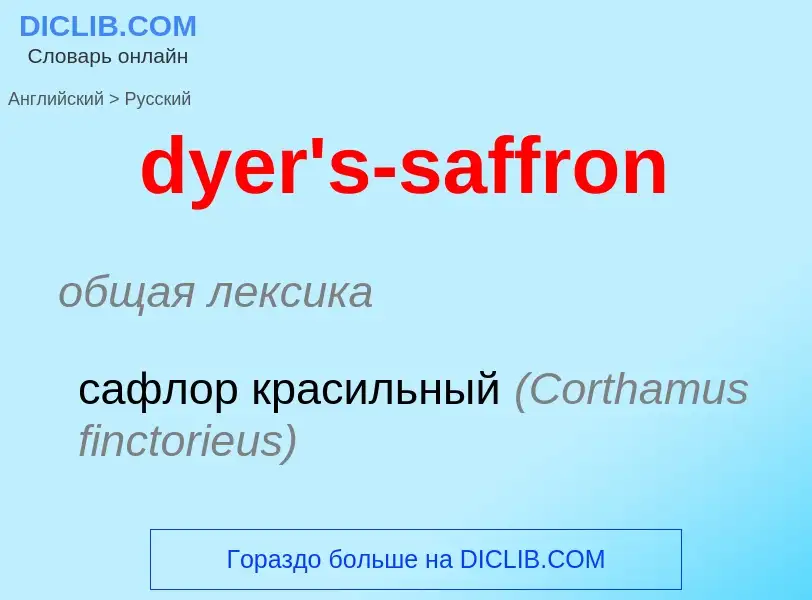Vertaling en analyse van woorden door kunstmatige intelligentie ChatGPT
Op deze pagina kunt u een gedetailleerde analyse krijgen van een woord of zin, geproduceerd met behulp van de beste kunstmatige intelligentietechnologie tot nu toe:
- hoe het woord wordt gebruikt
- gebruiksfrequentie
- het wordt vaker gebruikt in mondelinge of schriftelijke toespraken
- opties voor woordvertaling
- Gebruiksvoorbeelden (meerdere zinnen met vertaling)
- etymologie
dyer's-saffron - vertaling naar russisch
общая лексика
сафлор красильный (Corthamus finctorieus)
['sæfrən]
общая лексика
шафран посевной (Crocus sativus)
сафрон
шафрановый
прилагательное
общая лексика
шафранный, шафрановый
существительное
общая лексика
тёмно-оранжевый цвет
цвет шафрана
ботаника
шафран (Crocus sativus)
шафран
глагол
общая лексика
окрашивать шафраном или в шафрановый цвет
Definitie
Wikipedia

Phaeolus schweinitzii, commonly known as velvet-top fungus, dyer's polypore, dyer's mazegill, or pine dye polypore, is a fungal plant pathogen that causes butt rot on conifers such as Douglas-fir, spruce, fir, hemlock, pine, and larch. P. schweinitzii is a polypore, although unlike bracket fungi the fruiting body may appear terrestrial when growing from the roots or base of the host tree.
The fruiting bodies, appearing in late summer or fall, commonly incorporate blades of grass, twigs, or fallen pine needles as they grow. They are tannish with darker brown centres, with orange to pale margins on young specimens. They may grow beyond 25 cm in diameter. As the fruiting bodies age, the pore surface turns from yellow to greenish yellow, the top becomes darker, and the yellow-brown flesh becomes harder and more wood-like. The pores bruise brown. The spores are white, elliptical, smooth, and inamyloid.
The effect, impact and significance of infection by this fungus is rooted in the fact that it causes brown rot, which degrades the cellulose. Thus there is a loss of tensile strength which often leads to brittle fracture near the stem base, even at a fairly early stage of decay. Decay initiated above ground can lead to branch snap or breakout.
P. schweinitzii is native to North America and Eurasia, and has been identified as an exotic species in New Zealand, Australia, and South Africa. It is not edible.
As its common name suggests, the dyer's polypore is an excellent natural source of green, yellow, gold, or brown dye, depending on the material dyed and the mordant used.
P. schweinitzii is named after Lewis David de Schweinitz, a Pennsylvania-born Moravian minister and important early American mycologist.
Similar species include Heterobasidion irregulare, H. occidentale, Inonotus dryophilus, and Onnia tomentosa.






![Akrotiri]], on the Aegean island of Santorini. Akrotiri]], on the Aegean island of Santorini.](https://commons.wikimedia.org/wiki/Special:FilePath/Cueilleuse de safran, fresque, Akrotiri, Grèce.jpg?width=200)

![Buddhist adepts wearing saffron-coloured robes, pray in the Hundred Dragons Hall, [[Buddha Tooth Relic Temple and Museum]], Singapore. Buddhist adepts wearing saffron-coloured robes, pray in the Hundred Dragons Hall, [[Buddha Tooth Relic Temple and Museum]], Singapore.](https://commons.wikimedia.org/wiki/Special:FilePath/Maitreya Bodhisattva and Monks Singapore.jpeg?width=200)

![[[Kashmir]]i saffron package [[Kashmir]]i saffron package](https://commons.wikimedia.org/wiki/Special:FilePath/Pure Kashmiri saffron pack 08.jpg?width=200)
![Saffron market in [[Mashad]], [[Iran]] Saffron market in [[Mashad]], [[Iran]]](https://commons.wikimedia.org/wiki/Special:FilePath/SaffMHD.jpg?width=200)




![Razavi Khorasan]], [[Iran]] Razavi Khorasan]], [[Iran]]](https://commons.wikimedia.org/wiki/Special:FilePath/Saffronfarm-860808.jpg?width=200)
![Razavi Khorasan]], [[Iran]] Razavi Khorasan]], [[Iran]]](https://commons.wikimedia.org/wiki/Special:FilePath/860808-Saffronfarm-02-IMG 7674-2.jpg?width=200)
![Razavi Khorasan]], [[Iran]] Razavi Khorasan]], [[Iran]]](https://commons.wikimedia.org/wiki/Special:FilePath/860808-Saffronfarm-07-IMG 7888-2.jpg?width=200)
![Razavi Khorasan]], [[Iran]] Razavi Khorasan]], [[Iran]]](https://commons.wikimedia.org/wiki/Special:FilePath/860808-Saffronfarm-09-IMG 8077-2.jpg?width=200)
![Torbat-e Heydarieh]], [[Iran]] Torbat-e Heydarieh]], [[Iran]]](https://commons.wikimedia.org/wiki/Special:FilePath/Saffron-IMG 6634-2.jpg?width=200)
![Torbat-e Heydarieh]], [[Iran]] Torbat-e Heydarieh]], [[Iran]]](https://commons.wikimedia.org/wiki/Special:FilePath/Saffron-IMG 6603-3-2.jpg?width=200)
![Razavi Khorasan]], [[Iran]] Razavi Khorasan]], [[Iran]]](https://commons.wikimedia.org/wiki/Special:FilePath/860800-Torbat-SaffronFarm-IMG 7811.jpg?width=200)
![Torbat-e Heydarieh]], [[Iran]] Torbat-e Heydarieh]], [[Iran]]](https://commons.wikimedia.org/wiki/Special:FilePath/Saffron-IMG 6681-2.jpg?width=200)
![Razavi Khorasan]], [[Iran]] Razavi Khorasan]], [[Iran]]](https://commons.wikimedia.org/wiki/Special:FilePath/860800-Torbat-SaffronFarm-IMG 7883.jpg?width=200)
![Razavi Khorasan]], [[Iran]] Razavi Khorasan]], [[Iran]]](https://commons.wikimedia.org/wiki/Special:FilePath/860800-Torbat-SaffronFarm-IMG 7935.jpg?width=200)
![Razavi Khorasan]], [[Iran]] Razavi Khorasan]], [[Iran]]](https://commons.wikimedia.org/wiki/Special:FilePath/860808-Saffronfarm-04-IMG 7840-2.jpg?width=200)
![Razavi Khorasan]], [[Iran]] Razavi Khorasan]], [[Iran]]](https://commons.wikimedia.org/wiki/Special:FilePath/860800-Torbat-SaffronFarm-IMG 7983.jpg?width=200)
![Razavi Khorasan]], [[Iran]] Razavi Khorasan]], [[Iran]]](https://commons.wikimedia.org/wiki/Special:FilePath/860808-Saffronfarm-03-IMG 7821-2.jpg?width=200)
![Razavi Khorasan]], [[Iran]] Razavi Khorasan]], [[Iran]]](https://commons.wikimedia.org/wiki/Special:FilePath/860808-Saffronfarm-10-IMG 8033-2.jpg?width=200)
![Torbat-e Heydarieh]], [[Iran]] Torbat-e Heydarieh]], [[Iran]]](https://commons.wikimedia.org/wiki/Special:FilePath/Saffron-IMG 6644-2.jpg?width=200)
![Torbat-e Heydarieh]], [[Iran]] Torbat-e Heydarieh]], [[Iran]]](https://commons.wikimedia.org/wiki/Special:FilePath/Saffron-IMG 6640-2.jpg?width=200)
![Razavi Khorasan]], [[Iran]] Razavi Khorasan]], [[Iran]]](https://commons.wikimedia.org/wiki/Special:FilePath/860808-Saffronfarm-08-IMG 7959-2.jpg?width=200)
![Razavi Khorasan]], [[Iran]] Razavi Khorasan]], [[Iran]]](https://commons.wikimedia.org/wiki/Special:FilePath/860808-Saffronfarm-06-IMG 7879-2.jpg?width=200)
